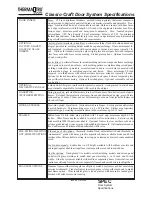
1.
Open the battery compartment Remove the battery from the packaging.
2.
Insert the battery with the correct polarity (+/
-
) in the battery compartment.
3.
Close battery compartment cover
➔
The device is ready for programming. The reader antenna is activated!
Important: Take the battery out for storage and transport!
When unpacking, check whether the components as per the description are present.
Dispose of the packaging in accordance with the applicable regulations of your country.
Sliding door lock PROXY RFID125 kHz installation
Insert battery
Sliding door lock PROXY RFID125 kHz general survey
Window for remo-
ving for cable
connection and
mounting the cover
Screwing holes
Card reader panel
sliding door lock PROXY RFID125 kHz assembly Instructions
Program the Sliding door lock PROXY RFID125 kHz
On delivery, the lock is neutral. Programming can be carried out/altered at any time, as described
in the following. Standard configuration means wheater the programming card nor the transpon-
der is programmed. The audible signal is
„
on
“
and the mode
„
standard
“
is activated (automatically
closing of the latch). The programming procedure as described in the following, can be done/
changed at every time.
1.) Store programming card: press the programming button of the lock for 3 seconds, until a long
signal tone and immediately afterwards a ticking is audible for approx. 7 seconds. During the
ticking, you must hold the programming card against the card reader panel, until a confirmation
tune is audible.
➔
The programming card is now stored.
Note:
When using a new programming card the memory will be erased (long signal). If the pro-
gramming button has been pressed too short the lock begins to tick, and an alarm will sound. You
have now turned the identification signal off (see point 7).
2.) Store transponder: hold the stored program card once against the card reader panel.
➔
A ticking is audible for approx. 7 seconds. During the ticking, hold the transponder (key fob)
against the card reader panel to read it in, until a confirmation signal is sounded (2 x 3 short
beeps).
➔
The transponder is now stored.
3.) Check transponder for function: hold the transponder once against the card reader panel.
➔
The confirmation signal is sounded again, the latch moves back and the lock opens. Repeat
the process 2 to 3 times to store further transponders. You can teach at maximum 1 programming
card and 50 transponder at once. The programming card and the transponder can be teached in
at several other locks.
4.) Delete stored transponders individually: hold the programming card once against the card
reader panel. A ticking is heard for approx. 7 seconds. During the ticking, hold the transponder
against the card reader panel to delete it, until a confirmation signal is sounded.
➔
The transponder is deleted.
5.) Open the latch e.g. with programming card and hold the latch in this position: Put the program-
ming card 4x to the card reader panel. The latch will hold open until a authorised transponder will
reset the hold open function.
➔
All saved transponders are stored, the latch is moved into the open position.
6.) Delete all stored transponders: hold the programming card 5x against the card reader panel
until a long confirmation signal is sounded.
➔
All saved transponders are deleted, the latch is moved into the open position.
7.) Switch signal tone on or off: keep the programming button pressed for max. one second.
➔
The signal tone is switched off/on.
Note!
The lock can be operated in two modes :
Mode
Standard
=
latch function
:
Only programmed transponders can lock/unlock the drawer lock. After the identification of an
authorized transponder, the latch moves to the open position and then moves back automatically
to the closed position.
Mode
open/closed
=
bolt function
:
After the identification of an authorized transponder, the latch moves to the open position and
stops in this position. At the next identification of the authorized transponder, the latch moves to
the close position and stops in this position.
The change is made with special service
-
cards (sold separately).
Hole for the cable when using an
external antenna
Exchangeable
latch / bolt
Screwing hole
Programming button
(RESET)
Press careful:
-
RESET
-
3 seconds
-
Sound on / off
1 short press
Note!
The lock assembly of furniture and the closing part must always be mounted so
that the door in the closed state has at least 0.5 mm distance. This tolerance is
necessary for the emergency opening in case of the low battery. Make sure that
the transponder used have a very good reading quality. There should always be a
comfortable reading distance be available from the front of the cabinet of at least
5
-
10 mm . The mounting distance between two locks should be approx. 10 cm.
There is otherwise a risk of interference of the fields of the card reading panels.
That can cause discharge of the battery.
Important!
RFID reading distance
PROXY KeyFob
up to 25 mm
PROXY cards
up to 30 mm
Check reading distance after assembling!
Important!
Assembling distance for RFID Signal
(alternative
-
external antenna)
mind. 10cm
mind. 20cm
EEC
-
Declaration of Conformity
in accordance with the directives
2004/108/EC
Directive on electro
-
magnetic compatibility (EMC)
1999/5/EC 1999
Directive on radio equipment and telecommunications
terminal equipment and the mutual recognition of their
conformity (R&TTE)
2002/96/EC 2003
Directive on waste electric and electronic equipment
(WEEE)
2011/65/EC
Directive on the restriction of the use of certain ha-
zardous substances in electrical and electronic
equipment (recast)
for the product:
sliding door lock PROXY 125 kHz
The following harmonised standards are applied:
EN 300330.2 V1.3.1 : 2006
EN 301489
-
3 V1.4.1 : 2002
EN ISO 12100: 2010
EN 50364 : 2010




















